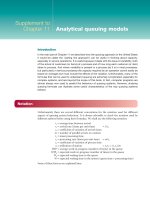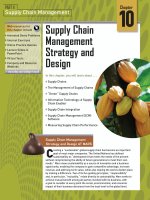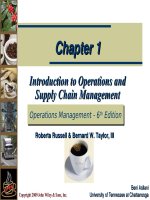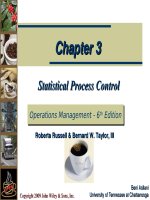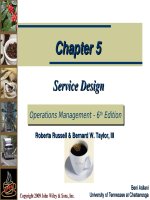Operation management 6e by russel and taylor ch05
Bạn đang xem bản rút gọn của tài liệu. Xem và tải ngay bản đầy đủ của tài liệu tại đây (2.2 MB, 46 trang )
Chapter 5
Service Design
Operations
Operations Management
Management -- 66thth Edition
Edition
Roberta Russell & Bernard W. Taylor, III
Copyright 2009 John Wiley & Sons, Inc.
Beni Asllani
University of Tennessee at Chattanooga
Lecture Outline
Service Economy
Characteristics of Services
Service Design Process
Tools for Service Design
Waiting Line Analysis for
Improvement
Service
Copyright 2009 John Wiley & Sons, Inc.
5-2
Service Economy
Source: U.S. Bureau of Labor Statistics, IBM Almaden Research Center
Copyright 2009 John Wiley & Sons, Inc.
5-3
Copyright 2009 John Wiley & Sons, Inc.
5-4
Characteristics of Services
Services
acts, deeds, or performances
Goods
tangible objects
Facilitating services
accompany almost all purchases of goods
Facilitating goods
accompany almost all service purchases
Copyright 2009 John Wiley & Sons, Inc.
5-5
Continuum from
Goods to Services
Source: Adapted from Earl W. Sasser, R.P. Olsen, and D. Daryl Wyckoff,
Management of Service Operations (Boston: Allyn Bacon, 1978), p.11.
Copyright 2009 John Wiley & Sons, Inc.
5-6
Characteristics
of Services (cont.)
Services are
intangible
Service output is
variable
Services have higher
customer contact
Services are
perishable
Service inseparable
from delivery
Services tend to be
decentralized and
dispersed
Services are
consumed more often
than products
Services can be easily
emulated
Copyright 2009 John Wiley & Sons, Inc.
5-7
Service
Design
Process
Copyright 2009 John Wiley & Sons, Inc.
5-8
Service Design
Process (cont.)
Service concept
purpose of a service; it defines target
market and customer experience
Service package
mixture of physical items, sensual
benefits, and psychological benefits
Service specifications
performance specifications
design specifications
delivery specifications
Copyright 2009 John Wiley & Sons, Inc.
5-9
Service Process Matrix
Copyright 2009 John Wiley & Sons, Inc.
5-10
High v. Low Contact
Services
Design
Decision
High-Contact Service
Facility Convenient to
location
customer
Facility
layout
Low-Contact Service
Near labor or
transportation source
Must look presentable, Designed for
accommodate
efficiency
customer needs, and
facilitate interaction
with customer
Source: Adapted from R. Chase, N. Aquilano, and R. Jacobs, Operations Management for Compensative Advantage (New York:McGraw-Hill,
2001), p. 210
Copyright 2009 John Wiley & Sons, Inc.
5-11
High v. Low Contact
Services (cont.)
Design
Decision
High-Contact Service
Low-Contact
Service
Quality
control
More variable since
Measured against
customer is involved in
established
process; customer
standards; testing
expectations and
perceptions of quality
and rework possible
may differ; customer
to correct defects
present when defects
occur
Capacity
Excess capacity
required to handle
peaks in demand
Planned for average
demand
Source: Adapted from R. Chase, N. Aquilano, and R. Jacobs, Operations Management for Compensative Advantage (New York:McGraw-Hill,
2001), p. 210
Copyright 2009 John Wiley & Sons, Inc.
5-12
High v. Low Contact
Services (cont.)
Design
Decision
High-Contact Service
Low-Contact
Service
Worker skills
Must be able to
interact well with
customers and use
judgment in decision
making
Technical skills
Scheduling
Must accommodate
customer schedule
Customer
concerned only
with completion
date
Source: Adapted from R. Chase, N. Aquilano, and R. Jacobs, Operations Management for Compensative Advantage (New York:McGraw-Hill,
2001), p. 210
Copyright 2009 John Wiley & Sons, Inc.
5-13
High v. Low Contact
Services (cont.)
Design
Decision
High-Contact Service
Low-Contact
Service
Service
process
Mostly front-room
Mostly backactivities; service may
room activities;
change during delivery
planned and
in response to
customer
executed with
minimal
interference
Service
package
Varies with customer;
includes environment
as well as actual
service
Fixed, less
extensive
Source: Adapted from R. Chase, N. Aquilano, and R. Jacobs, Operations Management for Compensative Advantage (New York:McGraw-Hill,
2001), p. 210
Copyright 2009 John Wiley & Sons, Inc.
5-14
Tools for Service Design
Service blueprinting
line of influence
line of interaction
line of visibility
line of support
Front-office/Backoffice activities
Servicescapes
space and function
ambient conditions
signs, symbols, and
artifacts
Quantitative
techniques
Copyright 2009 John Wiley & Sons, Inc.
5-15
Service Blueprinting
Copyright 2009 John Wiley & Sons, Inc.
5-16
Service Blueprinting (Con’t)
Copyright 2009 John Wiley & Sons, Inc.
5-17
Elements of
Waiting Line Analysis
Operating characteristics
average values for characteristics that describe
performance of waiting line system
Queue
a single waiting line
Waiting line system
consists of arrivals, servers, and waiting line
structure
Calling population
source of customers; infinite or finite
Copyright 2009 John Wiley & Sons, Inc.
5-18
Copyright 2009 John Wiley & Sons, Inc.
5-19
Elements of
Waiting Line Analysis (cont.)
Arrival rate (λ)
frequency at which customers arrive at a waiting line
according to a probability distribution, usually Poisson
Service time (μ)
time required to serve a customer, usually described by
negative exponential distribution
Service rate must be shorter than arrival rate (λ < μ)
Queue discipline
order in which customers are served
Infinite queue
can be of any length; length of a finite queue is limited
Copyright 2009 John Wiley & Sons, Inc.
5-20
Elements of
Waiting Line Analysis (cont.)
Channels
number of
parallel
servers for
servicing
customers
Phases
Copyright 2009 John Wiley & Sons, Inc.
number of
servers in
sequence a
customer
must go
through
5-21
Operating Characteristics
Operating characteristics are assumed to approach
a steady state
Copyright 2009 John Wiley & Sons, Inc.
5-22
Traditional Cost Relationships
as service improves, cost increases
Copyright 2009 John Wiley & Sons, Inc.
5-23
Psychology of Waiting
Waiting rooms
magazines and
newspapers
televisions
Bank of America
Disney
costumed characters
mobile vendors
accurate wait times
special passes
mirrors
Supermarkets
magazines
“impulse purchases”
Copyright 2009 John Wiley & Sons, Inc.
5-24
Psychology of Waiting (cont.)
Preferential treatment
Grocery stores: express lanes for customers with
few purchases
Airlines/Car rental agencies: special cards available
to frequent-users or for an additional fee
Phone retailers: route calls to more or less
experienced salespeople based on customer’s
sales history
Critical service providers
services of police department, fire department, etc.
waiting is unacceptable; cost is not important
Copyright 2009 John Wiley & Sons, Inc.
5-25

